Deterministic switching to single soliton state of optical microresonator frequency combs
H. Guo, M. Karpov, E. Lucas, et al. Nature Physics (2017)
The discovery of microresonator frequency combs since 2007 and the demonstrated formation of intracavity dissipative Kerr solitons (DKS) in following years have enabled to transfer this novel technology to advanced applications, including massively parallel coherent optical communications, dual-comb spectroscopy, and a microwave-to-optical link via self-referencing. Among those applications, the single soliton state is of particular interest as it enables a smooth spectral envelope and gives access to an ultra-short femtosecond pulse train. One problem remains as the frequency comb will not directly access to the single soliton state but in most cases be in a multi-soliton state where a number (N) of solitons exhibits stochastic dynamics, including an unpredictable soliton decay.
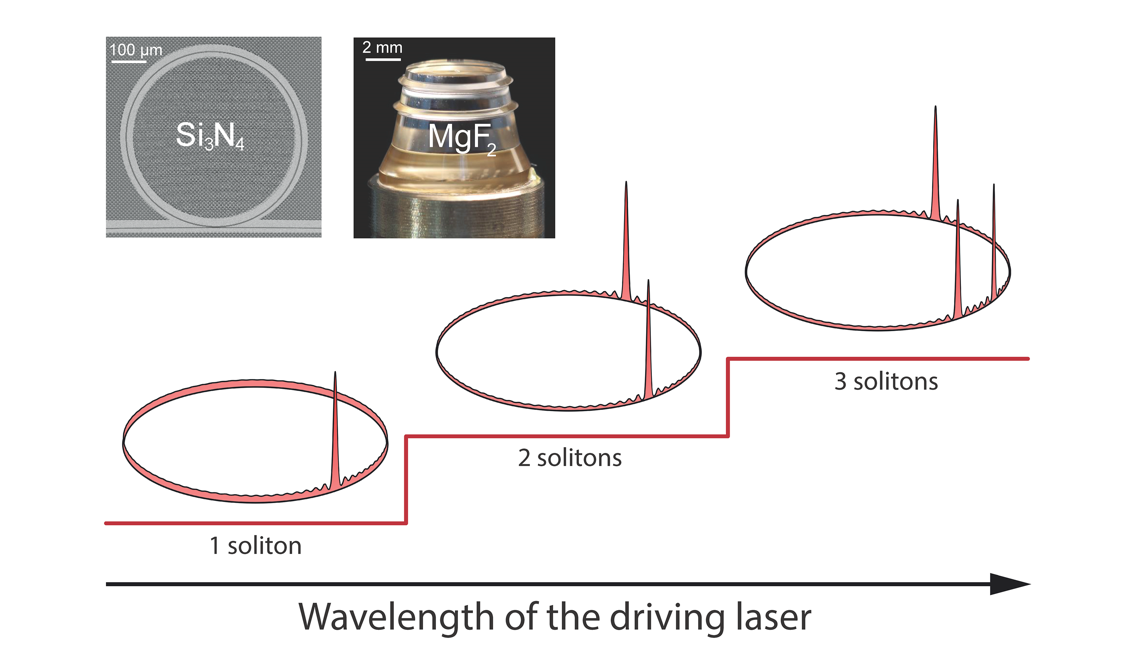
One of our recent research solved this problem, reporting the discovery of a soliton switching mechanism that enables a successive decay of intracavity solitons (N→N−1) and therefore provides a deterministic access to each soliton state in particular the single soliton state.
In experiments, such a deterministic soliton switching is implemented by a reverse tuning of the laser frequency, named as the backward tuning scheme, starting from any multi-soliton state. Such phenomenon is not predicted by the theory of the Lugiato-Lefever equation that predict the degeneracy of all soliton states over the laser detuning. However, we found out that it is the cavity-power-dependent thermal nonlinearity that lifts the degeneracy: each soliton state comprises a thermal shift that is dependent on the number of solitons (i.e. N-dependent). In this way, the backward tuning allows to access each soliton state, revealing a stair-like trace of the intracavity power, each step corresponding to a state with less solitons.
Moreover, we measured the system’s response to a pump modulation and found out that the soliton state shows a unique double-resonance feature in the response. This results from the bistability of the cavity in the soliton state, where the intracavity field consists of high-intensity soliton pulses on a low-intensity cw background. Due to the intensity-dependent Kerr nonlinearity, the soliton and the background each induce a distinct nonlinear resonance frequency shift, leading to the soliton-induced S-resonance and cw-related C-resonance in the system’s response. Importantly, the system’s response allows us to read the effective laser to resonance detuning despite the thermal nonlinearity. The number of solitons is also reflected on the amplitude of the S-resonance.

The system’s response also reveals the soliton switching dynamics, showing that the soliton decay only occurs when the two resonances are about to merge, at low detuning of the laser.
We also presented a theory based on our findings and performed numerical simulations. Both show excellent agreement to the experiments.
The two aspects of this work, i.e. the backward tuning scheme and the system’s response characterization, mark an important step towards applications of microresonator frequency combs. In particular a detuning stabilization can be applied to soliton-based frequency combs (reported in another later work). Equally important, this work contribute to highlight the Kerr nonlinear microresonators as an attractive platform for studying the dissipative soliton dynamics.
Quantum correlations of light due to its interaction with mechanical motion
V. Sudhir et.al., Phys. Rev. X 7, 011001 (2017)
It has been known since the early days of theoretical research in gravitation wave detection that when light reflects off of a mirror, vacuum fluctuations in the light impart a so-called quantum back-action force on the mirror. A consequence of this effect is that the quantum statistics of the reflected light differ from that of the incident light. For incident light that is in a coherent state, its amplitude vacuum fluctuations drive the mechanical oscillator, and this driven motion gets imprinted on the phase of the reflected light; thus the amplitude and phase of the reflected light develop correlations. We detect two manifestations of such correlations in an experiment. In the experiment, shown in Figure, the mechanical oscillator is the fundamental mode of glass nanostring which interacts with light stored in a whispering gallery mode optical cavity.
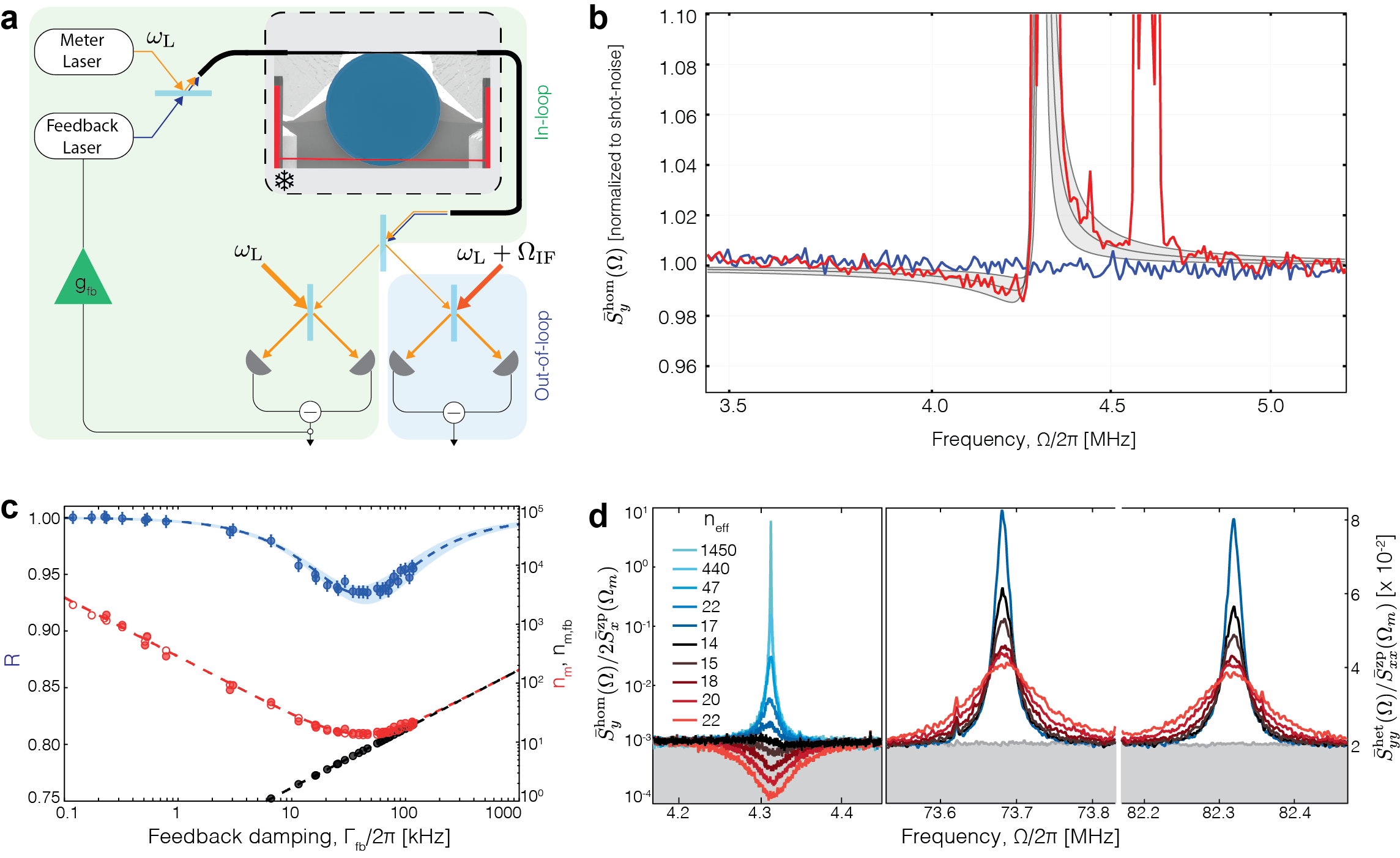
The light transmitted from the cavity is first detected using a balanced homodyne interferometer. In this case, correlations established between the phase and amplitude of the light manifest as squeezing of the homodyne photocurrent, i.e. a suppression below the level expected due to vacuum fluctuations. This is shown as the red trace in Figure(b).
It has been predicted that when the mechanical oscillator is sufficiently cold, the sidebands scattered by it from the probe laser exhibit an asymmetry corresponding to one phonon. In order to detect this asymmetry, we actively cool the oscillator using feedback; as shown in Figure(a), part of the cavity transmission is detected in an in-loop homodyne detector to provide the error signal to feedback cool the oscillator, while the remainder of the transmission is directed onto an out-of-loop heterodyne detector to measure the sidebands scattered by the oscillator. As the oscillator is cooled by feedback, the sidebands indeed have an asymmetry corresponding to one phonon – however, by being able to measure this effect simultaneously with optical squeezing, we are able to show that the asymmetry is also due to quantum correlations in the optical field.
Mid-infrared ultra-high-Q resonators based on fluoride crystalline materials
C. Lecaplain, C. Javerzac-Galy, et al. Nature Communica (2017)
Over the last decades, the unavailability of highly-transparent materials in the mid-infrared (mid-IR) has been the main limitation in the development of ultra-sensitive molecular sensors or cavity-based spectroscopy applications. Due to exceptional purity and low losses, whispering gallery mode microresonators based on polished alkaline earth metal fluoride crystals have attained ultra-high quality (Q) factor resonances (Q>108) in the near-infrared and visible. Recently we reported the leap towards ultra-high Q factors deep in the mid-infrared using crystalline microresonators.
We studied systematically the optical Q factors of four crystalline materials transparent in the mid-IR window of the alkaline earth metal fluoride XF2 family (where X=Ca, Mg, Ba, Sr).
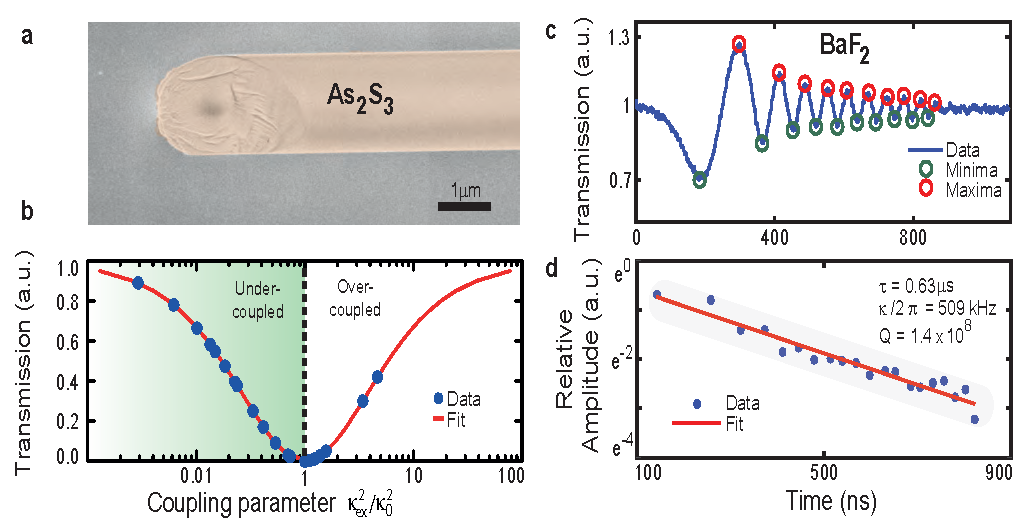
efficiency in the mid-IR. (c,d) Cavity ringdown method, enabling a measurement of the quality factor independently of the thermal nonlinearity and of the laser linewidth. We analyzed the transmission spectrum of the ringdown structure by measuring the amplitude decay of the remitted light.
To study the Q factors in the mid-IR we developed an efficient coupling technique based on an optical tapered fiber made out of chalcogenide (ChG) glass with a subwavelength waist Fig.1(a), so that light from a quantum cascade laser (QCL) can be evanescently coupled to a crystalline microresonator. In Fig.1(b) we show that critical coupling is achieved with high ideality, which is necessary for faithful Q factor measurements. We thus extend this technique for the first time to the mid-IR. We measured a critical factor of Qc ~107 of the MgF2 microresonator, a value close to the theoretical limit of multiphonon absorption at this wavelength. Using a cavity ringdown method (Fig.1(c) and (d)), we demonstrate for the first time ultra-high Q (>108) mid-IR resonances in BaF2 and SrF2 microresonators.
These microresonators feature ultra-high optical quality factors of Q > 1.4 x 108 at 4.4 um (more than a ten-fold improvement compared to previous results). Figure 2 summarizes the results of our measurements, from which we extracted the limiting values of the mid-IR intrinsic absorption at 4.4 um.
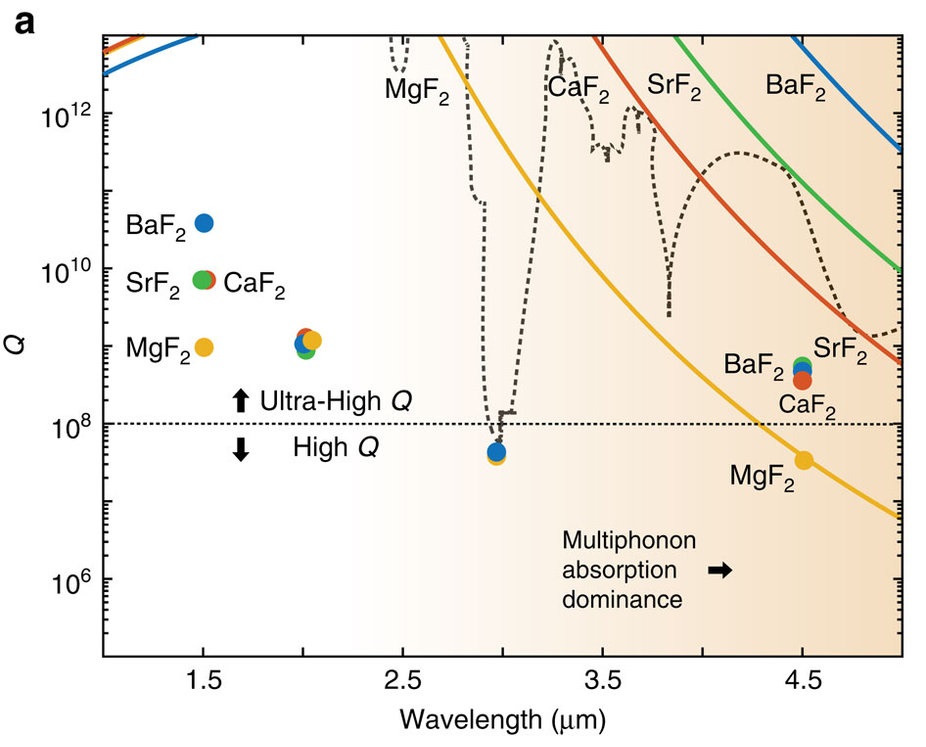
We show that a finesse as high as F ~ 4 x 104 is achievable using BaF2 and SrF2 in the mid-IR for cavities as small as few millimeters in diameter. This finesse represents a more than 1 order of magnitude improvement over prior high finesse cavities in this wavelength range. Our results in the mid-IR pave the way to the next generation of ultra-stable sources and ultra-precise spectrometers in the molecular fingerprint region and can further leverage QCL technology. Despite the differences with the near-infrared, we prove that the mid-IR region is not limited to the high-Q regime when proper materials are used (Fig.2). The crystalline nature of materials leads to low thermodynamical noise and moderate multiphonon absorption in the highly-relevant mid-IR region.
In addition, combining QCL with mid-IR ultra-high Q crystalline microresonators opens a route for mid-IR Kerr comb or soliton generation.
Raman Self-Frequency Shift of Dissipative Kerr Solitons in an Optical Microresonator
M. Karpov, H. Guo et al. Phys. Rev. Lett. (2016)
Temporal dissipative Kerr solitons in microresonators have opened immense opportunities for the development of microscale highly efficient optical frequency comb sources that can be applied in the areas of telecommunication, frequency metrology and spectroscopy. Microresonators operating in the soliton regime provide broadband and fully coherent optical frequency combs with repetition rates in the microwave domain. As nonlinear systems, microresonators allow for rich soliton dynamics as well as novel observations that impact the soliton formation process.
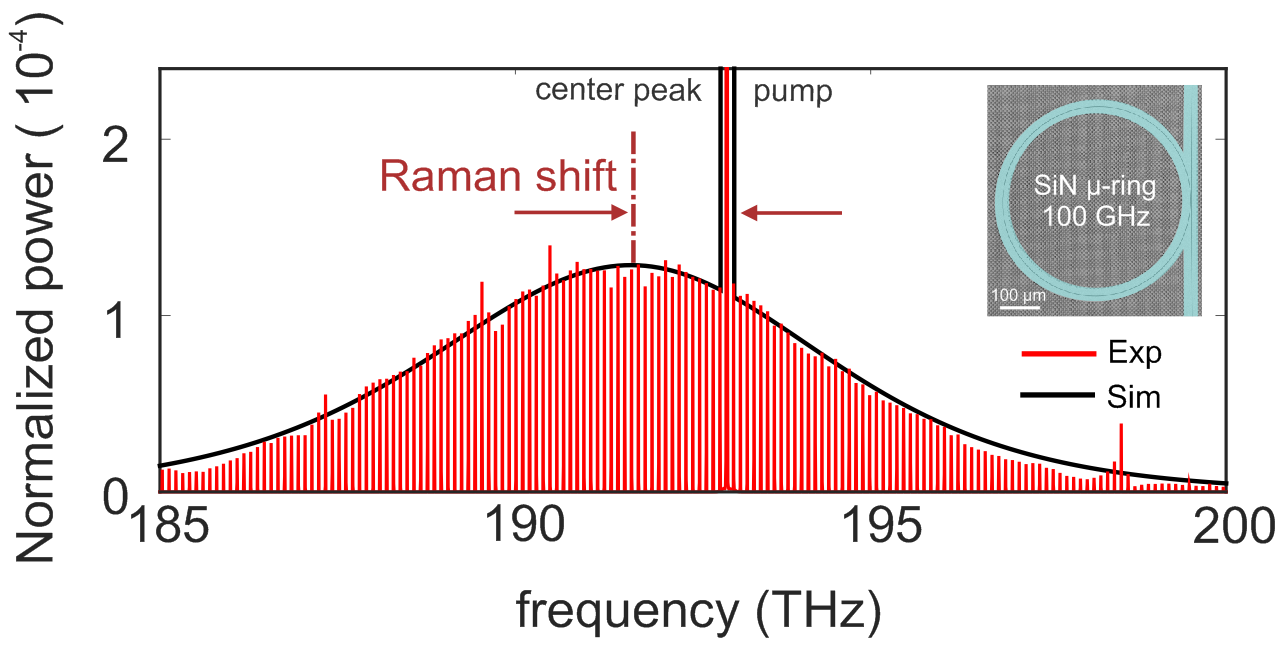
Our group has experimentally demonstrated the effect of intrapulse Raman scattering (IRS) for solitons in optical microresonators. The effect is well known in optical fibers, where it appears as the continuous red-shifting of the soliton spectrum over the propagation distance. We showed that IRS reveals himself differently in microresonators – the spectrum of the intracavity soliton has fixed spectral redshift with respect to the pump frequency. The phenomenon is explained by the formation of a new type of stable, self-consistent intracavity wavefroms – frequency-locked Raman solitons, which rely on the triple energy balance among cavity losses, gain from parametric pump conversion processes and intrapulse Raman scattering.
We also showed that IRS can interplay with high-order dispersive effect of the soliton dynamics – dispersive wave emission. The soliton spectral recoil produced by the dispersive wave emission, when the microresonator has significant third order dispersion, can counterbalance the IRS-induced soliton spectrum redshift. Moreover, the results let us estimate for the first time the Raman shock time of amorphous silicon nitride.
Photonic Damascene process for integrated high-Q microresonator based nonlinear photonics
Martin H. P. Pfeiffer et al., Optica (2016)
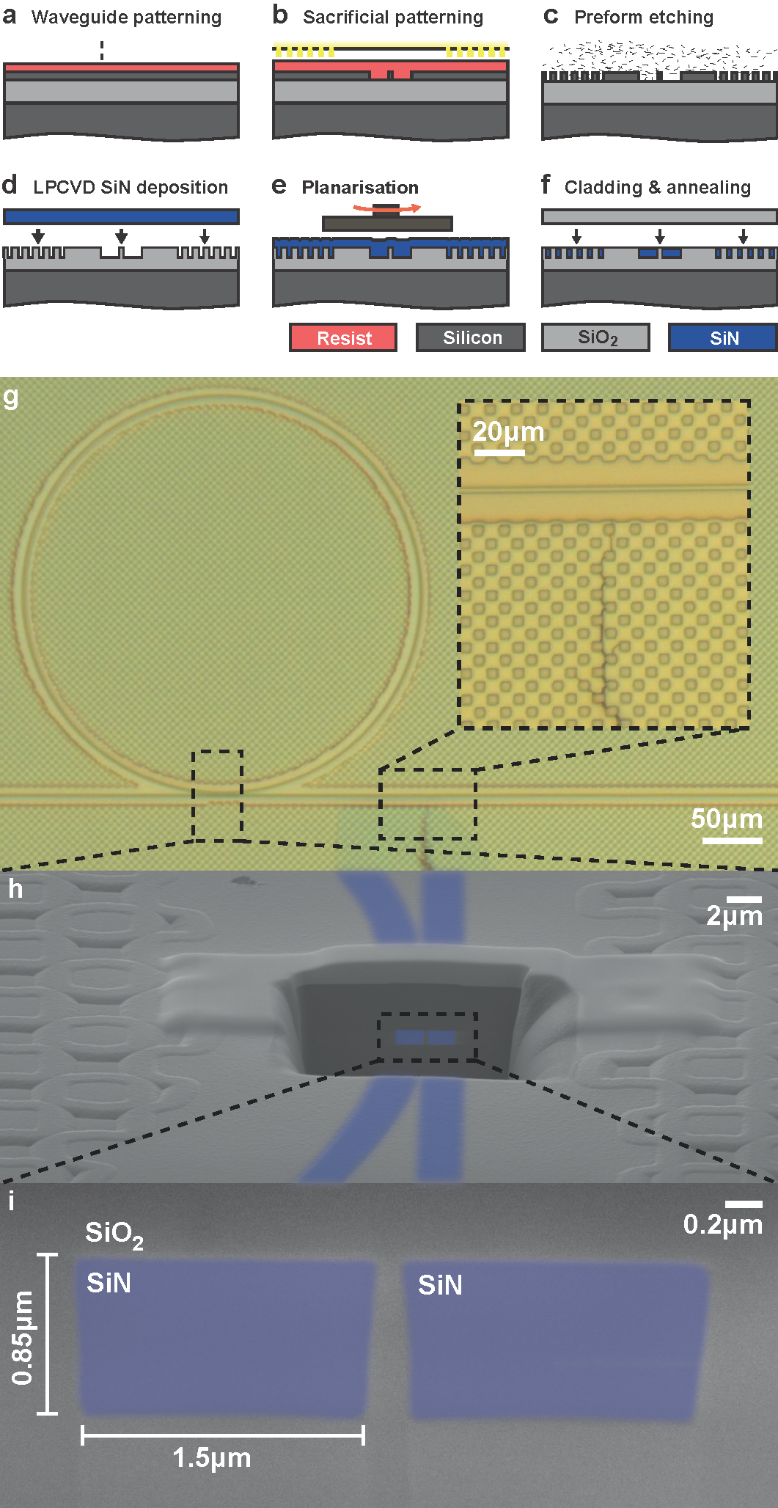
The fabrication of integrated, low loss silicon nitride (SiN) waveguides with dimensions that allow for anomalous group velocity dispersion at wavelengths around 1550nm remains challenging. This is due to several reasons, a very prominent one being the high tensile stress of the SiN thin film after deposition which leads to cracks. We developed an innovative photonic Damascene process (see Figure 1 a-f) that solves many of the challenges by depositing the SiN thin film on a prestructured wafer substrate.
The use of a dense filler pattern surrounding the waveguide structures (Fig.1 g) not only permits uniform planarization and removal of excess SiN but also Fig. 1 h-i shows the large waveguide cross sections and high aspect ratio coupling gaps that can be fabricated with high yield using this process. Resonators fabricated using this process feature linewidths as low as 50MHz and allow for generation of dissipative Kerr soliton based frequency combs.
Optical solitons in integrated microresonators for precision measurements
V. Brasch et al., Science (2015)

Eight years after the first demonstration of optical Kerr frequency combs generated in microresonators and two years after the demonstrating of dissipative Kerr solitons in crystalline microresonators our group was able to achieve another important step for the field of Kerr frequency combs: the generation of dissipative Kerr solitons in integrated microresonators. The big advantage of these integrated microresonators (the ring shown in Fig.1) is, that in contrast to crystalline resonators they can easily be mass-fabricated and that the geometry of the integrated resonators can be modified according to once needs using cleanroom techniques. In the future this can allow for the integration of such microresonators as frequency comb generators in instruments and devices.

One example that demonstrates the power of adapted geometries and in particular an adapted cross section of the integrated microresonators is also shown in our experiments. The spectrum of the frequency comb shows an effect known as dispersive wave or soliton Cherenkov radiation. This is a local maximum in the intensity spectrum clearly visible at around 155 THz in Fig.2. The position of this feature is determined by the dispersion of the microresonator which directly depends on its geometry. Choosing the geometry therefore allows to shift the maximum which can be important for applications such as in spectroscopy. An additional remarkable feature of the optical spectrum is its large span that reaches two-thirds of an octave, as indicated by the two green dashed lines in Fig.2.
The three aspects of this work, the solitons inside the silicon nitride integrated microresonator, the soliton Cherenkov radiation associated with it and the large optical span, mark another step towards the application of these Kerr frequency combs. Our follow-up work aims at a better understanding of the soliton dynamics as well as the Cherenkov radiation in order to improve reliability and performance of our integrated microresonators further.
Molecular Optomechanics
P. Roelli et al., Nature Nano. 264, (2015)
The discovery of the giant enhancement of Raman scattering from single molecules via surface plasmon had a transformative impact on spectroscopy and chemical analysis. Over the past decades a range of theories have been developed to describe the scattering of the amplified Raman signal. However recent experiments where maximal enhancement is achieved under excitation with a laser precisely blue-detuned from the plasmon resonance have revealed unexplained large nonlinear effects. We developed a new theory of plasmon-enhanced Raman scattering by mapping the problem to cavity optomechanics. We thereby revealed a new enhancement mechanism due to dynamical backaction amplification of molecular vibrations, which may explain previous observations and sheds new light on the physics of surface- and tip-enhanced Raman scattering.

Our model is based on the insight that the change in polarizability of a molecule under deformation (Raman tensor) leads to an optomechanical coupling to the plasmonic cavity constituted by a hot spot. Since the plasmon decay time can have a value comparable to the vibrational period (both tens of femtoseconds) the theory predicts that the localized plasmons in SERS are not only responsible for a huge electromagnetic field enhancement but should also exert a delayed “backaction” force on the molecular vibration. Under detuning, one component of this force is modulating the amplitude of the vibrational motion. Blue detuned excitation can thereby lead to amplification of the molecular vibration, while red detuned excitation to damping. Quantifying the vacuum optomechanical coupling rate for individual molecules in terms of the vibrational mode’s Raman activity, we find this coupling rate to be orders of magnitude larger than for microfabricated optomechanical systems. Our calculations reveal that dynamical backaction effects, leading to coherent amplification of the molecular motion, can take place in real systems.
This new insight is of major relevance for the design of novel nanostructures pushing the limits in sensitivity and resolution of nano-scale Raman spectroscopy and imaging. More radically, the theory lays the foundations of molecular cavity optomechanics and opens unforeseen research directions. The rich physics of cavity optomechanics is now accessible in systems of nanometric dimensions featuring coupling rates several orders of magnitude higher than state-of-the-art microfabricated devices.
Measurement-based feedback on a nanomechanical oscillator
D. J. Wilson et al., Nature 524, (2015)
In real-time quantum feedback protocols, the record of a continuous measurement is used to stabilize a desired quantum state. Recent years have seen highly successful applications in a variety of well-isolated micro-systems, including microwave photons and superconducting qubits. By contrast, the ability to stabilize the quantum state of a tangibly massive object, such as a nanomechanical oscillator, remains a difficult challenge: The main obstacle is environmental decoherence, which places stringent requirements on the timescale in which the state must be measured.
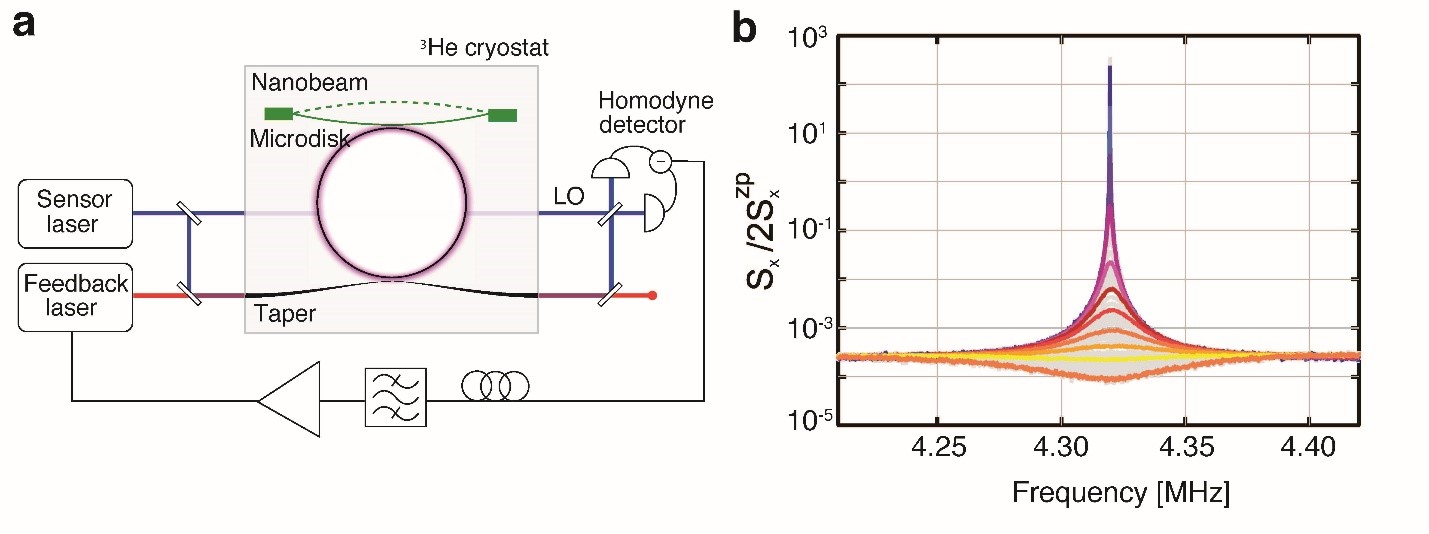
In a recent experiment performed in our group, we employ a position sensor capable of resolving the zero-point motion of a solid-state, nanomechanical oscillator in the timescale of its thermal decoherence, a critical requirement for preparing its ground state using feedback. The sensor is based on cavity optomechanical coupling, and realizes a measurement of the oscillator’s displacement with an imprecision 40 dB below that at the standard quantum limit, while maintaining an imprecision-back-action product within a factor of 5 of the Heisenberg uncertainty limit. Using the measurement as an error signal and radiation pressure as an actuator, we demonstrate active feedback cooling of the 4.3 MHz oscillator from a cryogenic bath temperature of 4.4 K to an effective value of 1.1 mK, corresponding to a mean phonon number of 5.3. Our results set a new benchmark for the performance of a linear position sensor, and signal the emergence of engineered mechanical oscillators as practical subjects for measurement-based quantum control.
Towards new tests of quantum mechanics at macroscopic scales
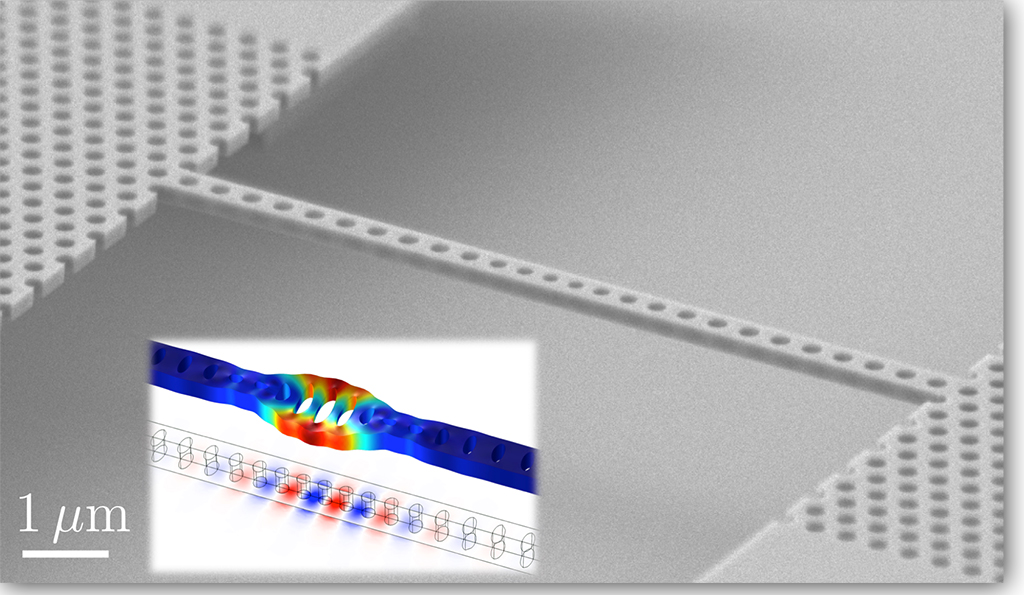
C. Galland et al., Phys. Rev. Lett. 112, 143602 (2014)
Quantum theory is our best available description of the behavior of light and matter at the atomic scale. One of the cornerstones of the theory is the quantization of energy. For light, this means that a beam cannot be attenuated continuously to arbitrarily low level. Eventually quantization becomes evident and one measures individual photons. Similarly, the motion of atoms is quantized.
One disturbing open question remains, and is recently regaining interest among experimental physicists: Why is our experienced world “classical”? Applying the laws of quantum mechanics to our macroscopic world leads to numerous paradoxes, such as the infamous live/dead superposition of Schrödinger’s cat. Is a quantum to classical transition occurring at an intermediate scale between atoms and cats? In other words, is it fundamentally impossible to prepare arbitrarily large and massive systems in a non-classical state? If not, would it be technically feasible using state-of-the-art experimental setups?
With collaborators at the University of Geneva we answer the last question affirmatively in a theoretical work published in Physical Review Letters. The scheme is based on cavity optomechanics and we assume realistic parameters: an optomechanical coupling rate much smaller than the cavity decay rate (weak coupling), itself being smaller than the mechanical frequency (resolved sideband). In contrast to previous proposals that required strong coupling, we prove that it is possible to prepare a single-phonon Fock state of the mechanical oscillator, even for weak optomechanical coupling. Technically, this is achieved by projective measurement upon the detection of a “herald” photon in the preparation stage, where the pump laser is tuned on the upper mechanical sideband. The non-classical nature of the motional state can further be verified in a readout stage by swapping the phonon and cavity modes under pumping of the lower sideband. The second-order correlations of the scattered (anti-Stokes) photons can be measured with Hanbury-Brown-Twiss setup and features antibunching, a signature of quantum statistics.
Temporal solitons in optical microresonators
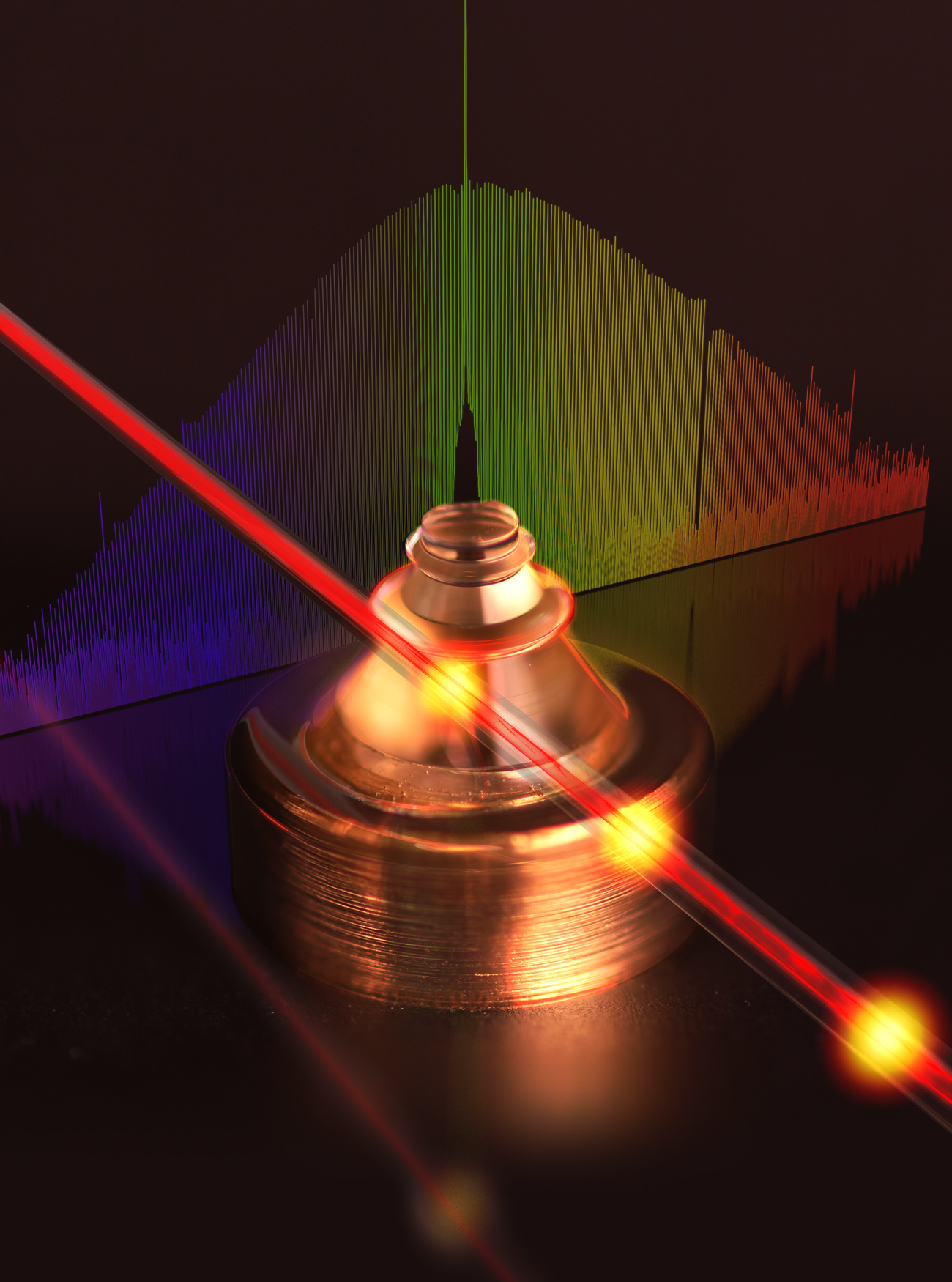
T. Herr et al., Nature Photonics 8, 145-152 (2014)
Waves in water usually widen as they travel and eventually disappear. Soliton water waves, in contrast, can travel for miles without changes in their shape or height. Now, we have discovered that optical soliton waves, that is solitons made of light, can exist in optical micro-resonators. These solitons can spontaneously form in the microresonator and remain stable as long as a pump laser continuously restores their energy. Essentially, the microresonator converts the continuous wave pump laser into a train of ultra-short optical pulses. No electronic feedback system is required to stabilize the solitons in the microresonator. This remarkable property, which greatly simplifies the system, is a result of the subtle interplay of nonlinear optical and thermal effects that naturally occurs in the microresonator. Besides being an intriguing nonlinear optical phenomenon the ultra-short soliton pulses could have significant impact on photonic technology.
In our first demonstration we have already observed pulse duration in the range from 100-200 fs. As the microresonator soliton pulses do not rely on broadband laser gain media or saturable absorbers, much shorter pulse durations can be expected from future microresonator systems. Moreover, the microresonator system can operate in wavelength regimes where broadband laser gain media or saturable absorbers are not available. The ultra-short pulses could serve in precise synchronization between remote locations and in future geo-navigation systems. IN the frequency domain the train of ultra-short pulses corresponds to a low noise frequency comb spectrum with smooth spectral envelope and wide line spacing. With these unique properties, the soliton frequency combs from a microresonator are ideal light sources in applications including high-capacity telecommunications, broadband precision spectroscopy and astronomical spectrometer calibration.
Stabilization of a linear nanomechanical oscillator to its thermodynamic limit
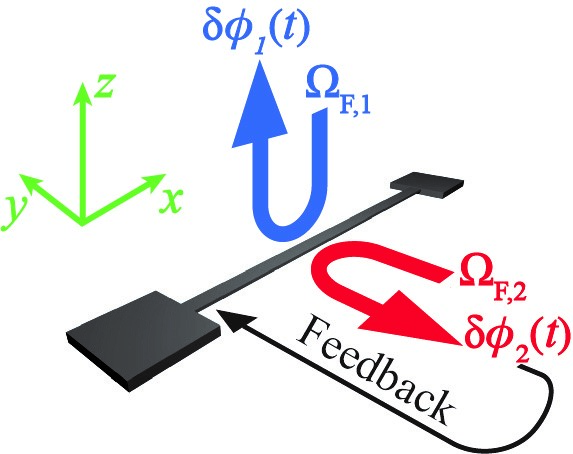
E. Gavartin et al., Nature Communications 4, 2860 (2013)
Thermal noise is well known to be an ubiquitous and fundamental limit for the sensitivity of micro- and nanomechanical oscillators. This noise arises from the unavoidable coupling of the mechanical device to a thermal bath, which is responsible for a motion with random amplitude and phase. A number of precision measurements based on using nanomechanical resonators, such as gradient force, mass and charge detection or time and frequency control, consist of detecting linear changes induced by the measured system on the phase of the coherently driven nanomechanical sensor. These applications are thus theoretically limited by the random phase fluctuations related to thermal motion. Decreasing the effect of thermal noise can be accomplished by increasing the relative contribution of the coherent drive. However, the latter has to be kept below a certain threshold, above which the mechanical oscillator becomes nonlinear: At this threshold thermal noise constitutes an irreducible sensing limit for linear nanomechanical measurements in the classical regime. In practice, even when driven close to their nonlinear onset, nanomechanical resonators presently operate far away from the thermal limit. Although several proposals have been made and implemented to decrease this excess phase noise, they are based on oscillators being driven into the nonlinear regime and require specific operating conditions, thus making the schemes difficult to adapt for a general class of resonators.
Here we introduce an approach that generally applies to nanomechanical resonators in the linear regime. This approach employs an auxiliary mechanical mode as a frequency noise detector, whose output is used to stabilize the frequency of the fundamental out-of-plane mode of a nanomechanical beam. Its experimental implementation enables quasi-optimal linear operation at room temperature, with an almost perfect external phase noise cancellation, as demonstrated for the nanomechanical beam driven just below its nonlinear onset. Hence, our system operates close to its thermodynamic linear sensing limit, meaning that neither technical improvements (for example, in displacement detection) nor a change in the resonator driving strength can improve the effective frequency stability of the linear oscillator. Our scheme can be readily incorporated into a variety of other systems used for applications in sensing, frequency control, parametric processes or fundamental studies.
Miniaturized, high power, mid-infrared frequency combs
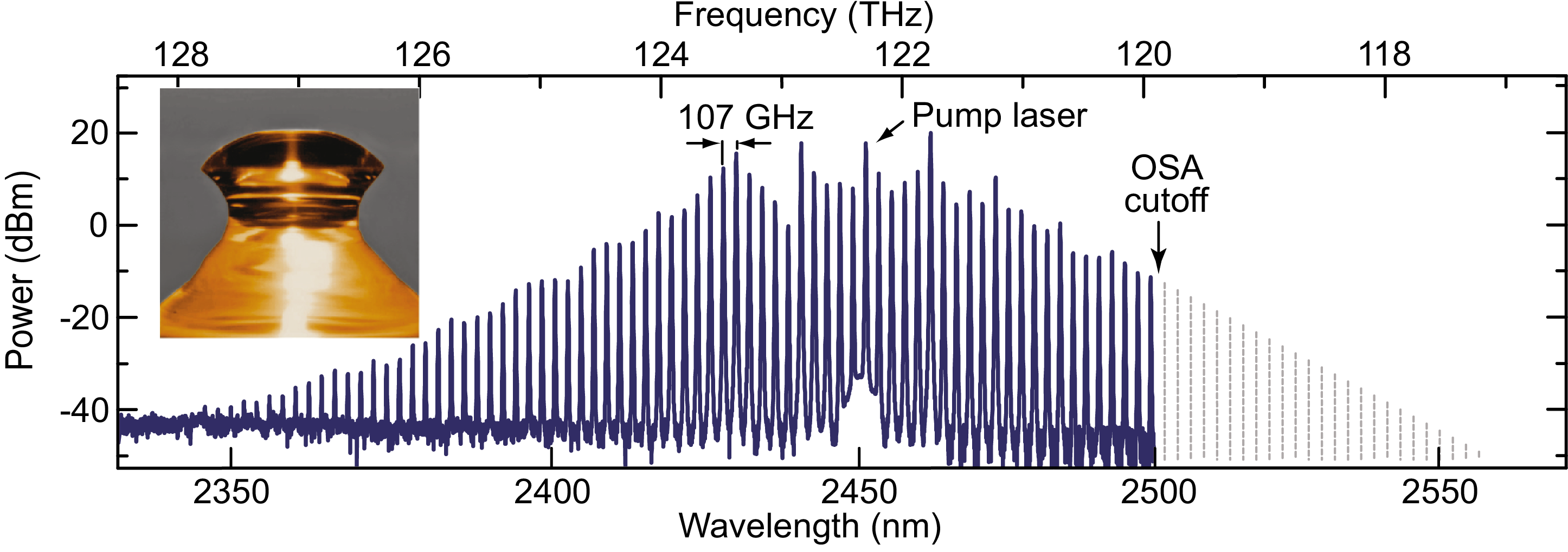
C.Y. Wang et al., Nature Communications 4, 1345 (2013)
Optical frequency comb generators are coherent light sources, which produce a “comb” of many precisely evenly spaced spectral lines. During the last decade, such combs have revolutionized the art of measuring the frequency of light, as recognized in 2005 by the award of the Physics Nobel Prize to Prof. Theodor W. Hänsch. Today frequency combs are becoming enabling tools for new and unexpected applications. In particular, frequency combs are strongly impacting molecular spectroscopy by dramatically improving the recording speed, the resolution and the accuracy of Fourier spectrometers. The mid-infrared spectral range, also called molecular fingerprint region, is of primary importance to molecular physics. However, emerging mid-infrared frequency comb techniques still need considerable improvements: the systems are often based on nonlinear frequency conversion of near-infrared laser sources, which makes them bulky, and their use is limited to specialists.
The new technique developed by the Laboratory of Photonics and Quantum Measurements with scientists at MPQ avoids these obstacles. Here, mid-infrared frequency comb radiation is generated by exciting whispering gallery modes in a small monolithic resonator. A crystalline micro-resonator with a quality-factor exceeding 109 is pumped by a continuous wave laser. By a nonlinear process called four-wave mixing, it produces a broad comb spectrum consisting of discrete lines spaced by 100 GHz at mid-infrared wavelengths near 2.5 μm. The remarkable characteristics of such comb generators are their small size, large line-spacing, high power per comb line, and efficient conversion. An appropriate choice of the material – here magnesium fluoride – and proper engineering are crucial to realize broad spectral span and low-phase noise, as required for frequency comb operation. Such miniaturized sources hold much promise for on-chip frequency-comb spectrometers. The spectrum of the fundamental vibrations of liquid phase samples might be measured within a few nanoseconds with a similar refresh time.
Microwaves in the pedestrian zone
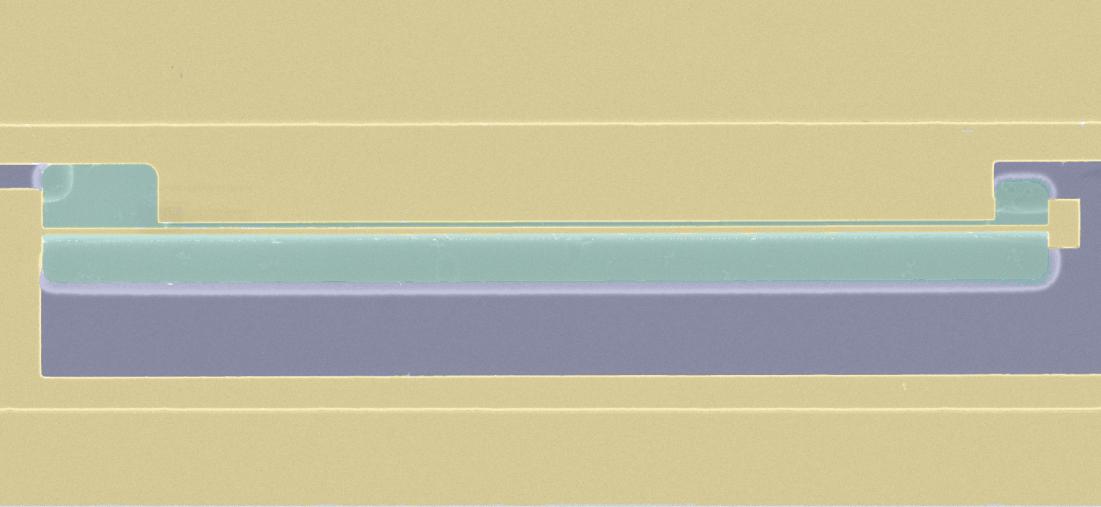
X. Zhou et al., Nature Physics 9, 179-184 (2013)
In collaboration with Walther-Meißner-Institut in Garching, we investigated superconducting microwave circuits coupled to nanomechanical oscillators. By analogy with phenomena known in atomic and optical physics, we found that the nanomechanical oscillator can mediate interference between microwaves, and exploited to control the propagation of microwave signals. In particular, we could create spectrally extremely sharp transmission windows (linewidth 10 Hz @ 200milliKelvin) for microwave signals, which are accompanied by very long delays on the order of milliseconds. Thus, a microwave pulse takes the same time to travel across the microchip as if it was sent in a 600 km coaxial cable.
Importantly, the width, delay, but also amplitude of the transmission window, i.e., the fraction of signal power that is transmitted, can be dynamically controlled by a second microwave field. Using classical microwave pulses, we have investigated these effects, and found a good agreement with our theory. In our work, we also addressed more subtle questions with regard to the possible temporal dynamics of the control that have been debated among experts, and found full agreement with our expectations. Another important result was that the system we implemented is capable of operating in a regime in which decoherence, a potentially detrimental effect for the processing of quantum information, is not a critical issue.
Hybrid on-chip opto-mechanical transducer
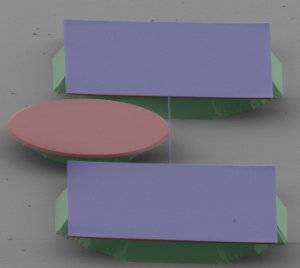
E. Gavartin et al., Nature Nanotechnology 7, 509–514 (2012)
Nanoscale mechanical oscillators have the potential to be used as very sensitive transducers of ultrasmall forces at the atto-Newton level. However, until now their mechanical motion was most often detected via electrical means, which routinely allows only an inefficient resolution of mechanical motion and requires specific materials limiting possible applications. In parallel, the highly developed and efficient optical readout techniques were limited to objects above the diffraction limit at the micron-scale.
In our work, we have combined a nanomechanical beam with an optical microresonator in an integrated on-chip device. By placing the beam in the near-field of the optical resonator, we were able to optically detect its motion with a high resolution. Moreover, we increased the force sensitivity of the mechanical transducer by reducing its mass to the femtogram range and increasing its mechanical quality factor. At the same time, we showed that performing an active feedback control of the oscillator via radiation pressure allows a significant decrease of the measurement time needed to detect a small incoherent force. With this technique we could retrieve a minute external force greatly buried in the background in less than a minute of averaging time. We envision our transducer to be used both for quantum optomechanical experiments as well as for demanding sensing applications.
Kerr-Frequency Comb Dynamics Revealed
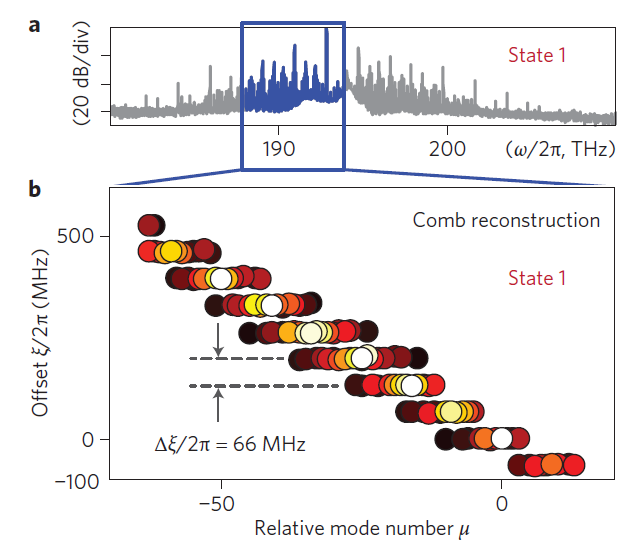
Figure: (a) Kerr-Frequency comb spectrum generated in a Silicon-Nitride microresonator (b) Precision broadband spectroscopy of the comb spectrum reveals that it consists of many individual frequency combs. Depending on their relative offsets these frequency combs can merge into a single, broadband and low-noise frequency combs.
T. Herr et al., Nature Photonics 6, 480–487 (2012)
Optical frequency combs allow for the precise measurement of optical frequencies and are used in a growing number of applications. The new class of Kerr-frequency comb sources, based on parametric frequency conversion in optical microresonators, can complement conventional systems in applications requiring high repetition rates such as direct comb spectroscopy, spectrometer calibration, arbitrary optical waveform generation and advanced telecommunications.
However, a severe limitation in experiments working towards practical systems is phase noise, observed in the form of linewidth broadening, multiple repetition-rate beat notes and loss of temporal coherence. These phenomena are not explained by the current theory of Kerr comb formation, yet understanding this is crucial to the maturation of Kerr comb technology. Here, based on observations in crystalline Magnesium-Fluoride and planar Silicon-Nitride microresonators, we reveal the universal, platform-independent dynamics of Kerr comb formation, allowing the explanation of a wide range of phenomena not previously understood, as well as identifying the condition for, and transition to, low-phase-noise performance.
A quantum connection between light and mechanics
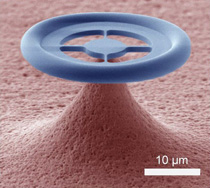
E. Verhagen et al., Nature 482, 63–67 (2012)
A microscopic system is demonstrated in which light can be converted into a mechanical oscillation and back. This interaction is so strong that it becomes possible to control the motion of the oscillator at the level where quantum mechanics governs its behavior. Quantum effects can only be observed on very well isolated systems, where the coupling to the surrounding environment is extremely weak. For large objects, the unavoidable coupling quickly washes out the quantum properties, in a process known as decoherence. Until recently, scientists were therefore only able to observe quantum mechanical traits in the motion of tiny systems, such as single atoms or molecules. Now, our laboratory has shown that it is possible to use light to control the motion of an object, sufficiently large to be seen with the naked eye, at the level where quantum mechanics dominates. Light circulating in a glass microtoroid exerts a small force on the structure, which can influence its mechanical motion. In fact, a small pulse of light can be transformed to a small vibration of the toroid. For the first time, this transformation is made to occur within a time that is short enough such that the quantum properties of the original light pulse are not lost in the process through decoherence. Simultaneously, the light cools down the motion of the object, such that the mechanical oscillator spends a large fraction of time in the quantum ‘ground state’. By outpacing decoherence, these results provide a powerful way to control the quantum properties of the oscillator motion, and see the peculiar predictions of quantum mechanics at play in human-made objects.
Octave Spanning Frequency Comb on a Chip
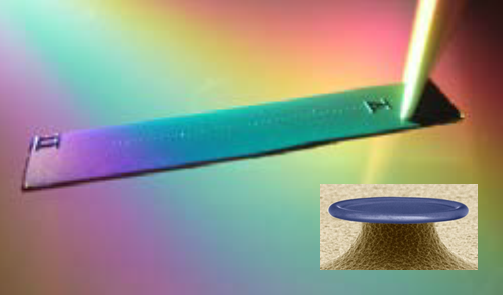
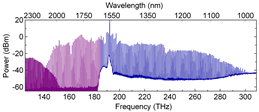
P. Del’Haye et al., Phys. Rev. Lett. 107, 063901 (2011)
Optical frequency combs are revolutionary tools for applied spectroscopy, metrology and fundamental physics. By providing accurate frequency markers the combs allow for determining optical frequencies with unprecedented accuracy. Conventionally, frequency combs are generated using mode locked lasers systems. An entirely novel approach to frequency comb generation has been demonstrated in 2007 by our laboratory based on nonlinear interactions (four-wave-mixing) of light in a fused silica microresonator. Here, the frequency the comb is generated around the frequency of a single continuous-wave laser, which is used to pump the device. Due to their monolithic design the on chip microresonators offer simplicity and extremely small form factors, which becomes important whenever size or weight matters. So far microresonator based frequency combs rely on external frequency references for their stabilization. A key step towards fully self-referenced (i.e. independent) microresonator frequency combs is generating an octave spanning spectrum enabling the so called f-2f-self-referencing scheme. This milestone result has only recently been demonstrated for the first time in our laboratory and further strengthens the viability of fully self-referenced microresonator based frequency combs. Further research towards this goal is under way.
Observation of optomechanical coupling in a photonic crystal defect cavity
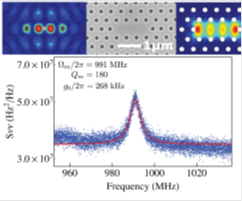
E. Gavartin et al., Phys. Rev. Lett. 106, 203902 (2011)
In collaboration with the LPN CNRS laboratory in Paris (Dr. I. Robert) we have demonstrated for the first time the coupling of a localized optical L3-photonic crystal defect cavity to a localized mechanical mode in the same structure. Due to the cavities small dimension the photonic crystal defect cavity also support GHz phonon modes that are highly localized and provide strong optomechanical coupling. Using a new measurement technique developed at EPFL with visiting Professor ML Gorodetsky (Moscow State University), we successfully observed for this first time this coupling in L3 defect cavities and quantified its strength, which exceeds the state of the art by almost two orders of magnitude. Future work will be concerned with measuring radiation pressure effects due to this coupling such as regenerative coherent amplifications of phonons, or observing optomechanically induced transparency.
Thermal noise limited crystalline reference cavity
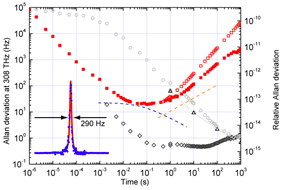
J. Alnis et al., Phys. Rev. A 84, 011804(R) (2011)
In collaboration with the frequency metrology division of T. W. Hänsch, we have explored the potential of crystalline WGM resonators as reference cavities. The resonators were realized as a fine-polished protrusion on a monolithic cylinder of magnesium fluoride. Due to their high finesse, they provide sharply defined resonance frequencies in spite of the devices’ compact size (~1 cm3).
We have measured the frequency stability of an external cavity laser locked to a WGM, and found that the linewidth of the diode laser could be reduced to below 290 Hz, with relative Allan deviations of the laser’s frequency down to the 10-14-level—limited only by fundamental thermodynamic fluctuations of the refractive index of the host material.
As they do not rely on wavelength-specific mirror coatings, crystalline WGM resonators can be employed to stabilize free-running lasers all across the wide transparency window of crystalline materials in compact setups with reduced vibration sensitivity.
Observation of Optomechanically Induced Transparency (OMIT)
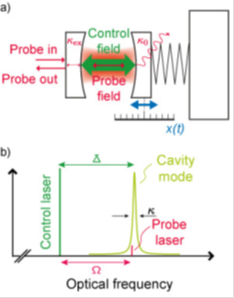
S. Weis et al., Science 330 (6010), 1520-1523 (2010)
Electromagnetically induced transparency is an effect which has allowed storage of optical pulses in atomic media. Moreover, it allows to control the propagation of light and has enabled slowing, enhancing and storage of light pulses. So far this phenomenon has utilized atoms or ions as storage medium. Our laboratory has demonstrated in 2010 that an analogous phenomenon can also occur in optomechanical systems in which a strong coupling laser couples optical and mechanical degree of freedom and leads to a transparency window for a weak probe beam. This phenomenon had been theoretically predicted and the work of our laboratory demonstrated the effect for the first time in an experimental setting. The phenomenon allows optical control of light propagation such as the slowing, storage and enhancement of pulse propagation in micro-fabrication optomechanical systems. Within our laboratory we presently seek to demonstrate this phenomena in photonic crystals to address photon phonon conversion experiments.
Optomechanical coupling in crystalline resonators

J. Hofer et al., Physical Review A 82, 031804 (2010)
Within the field of cavity opto-mechanics, an important aspect is to realize structures that both possess low optical absorption and low phonon propagation losses. While amorphous materials can exhibit low absorption for optical photons, the amorphous nature leads to generally a new loss mechanism due to two level fluctuators. These TLS are absent in crystalline materials such as MgF2 or CaF2. Our laboratory has been able to fabricate crystalline resonators with ultra-high optical Q using a micro-polishing method (see adjacent figure). The fabricated cylindrical resonators also exhibit high Q mechanical modes that we have identified and whose coupling we have established for the first time.
The optical Q-factor attained in these resonators have exceeded values of 10 billion which have moreover enabled to observe nonlinear optical frequency conversion (optical frequency comb generation) at high pumping powers as well as their use as laser reference cavity. Here crystalline resonators offer a compact and broadband solution to laser stabilization as used in e.g. Timekeeping, metrology or AMO Physics experiments.
Measurement below the Standard Quantum Limit
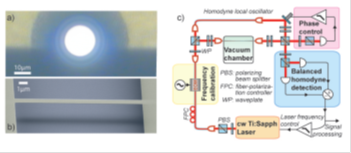
G. Anetsberger et al., Physical Review A 82, 061804 (2010)
Measuring nano-mechanical motion with an imprecision that is sufficient to resolve the zero point motion has been a longstanding subject of interest in Condensed Matter Physics and Quantum Optics alike. Using a method developed in our laboratory, we have demonstrated for the first time a measurement that allows measuring the motion of a nano-mechanical oscillator below the standard quantum limit.
The coupling of mechanical and optical degree in such systems can moreover reach a regime where the quantum backaction is dominant at room temperature – enabling experiments such as radiation pressure squeezing.
Optomechanical cooling close to the quantum regime
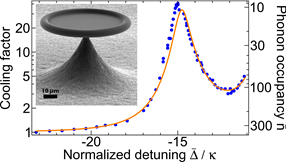
R. Rivière et al., Phys. Rev. A 83, 063835 (2011)
We demonstrate for the first time laser cooling of a macroscopic oscillator mass of 20ng down to a phonon occupancy of 9+/-1. Using an ultra-sensitive homodyne motion detection, we extract the optical spring and damping effects induced by the intracavity laser light onto the silica optomechanical resonator, initially precooled with an exchange gas 3He cryostat.
Under optimum detuning, the macroscopic oscillator mass is prepared to an occupancy corresponding to a quantum ground state occupation of 10% of the time. Novel thermometry based on silica two level systems (TLS) shows that intracavity absorption is largely reduced, enabled by operating deeply in the resolved sideband regime, a crucial prerequisite for reaching the ground state.
Further mechanical engineering of the structure already demonstrated in the group may soon allow to prepare the macroscopic mass fully into its quantum ground state.
Sideband cooling and position measurement of a micromechanical oscillator close to the Heisenberg uncertainty limit
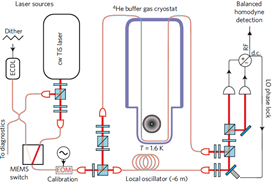
A. Schliesser et al., Nature Physics 5, 509-514 (2009)
Cooling a micromechanical oscillator to its quantum ground state is an important precondition for the preparation and control of the quantum states of such devices. As yet, this has only been achieved with a dedicated piezo-electromechanical system. Optical (resolved) sideband cooling, in contrast, is a versatile technique which we first demonstrated in 2008. It is now applied to a wide range of micro- and nanomechanical oscillators. In this work, we have successfully combined optical sideband cooling with cryogenic pre-cooling in a helium buffer gas. Importantly, the cooling laser is simultaneously used as an ultrasensitive displacement trans–ducer.
We could show that the measurement of the ultracold (phonon occupation ~60 quanta) oscillator’s displacement fluctuations can be performed close to the fundamental Heisenberg uncertainty limit. Such near-ideal displacement measurements are necessary for future optomechanical experiments in the quantum regime, and have been demonstrated for the first time in this work.
Ultra low dissipation optomechanical resonators
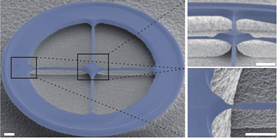
G. Anetsberger et al., Nature Photonics 2, 627 – 633 (2008)
In optomechanics, the viscous nature of the radiation pressure of an intracavity optical mode is used to perform cooling. This is equivalent to dissipatively linking the moving mass to a system exhibiting smaller fluctuations, i.e. colder. Evidently, on the race to macroscopic masses cooled to the quantum ground state, it is experimentally desired to engineer mechanical systems with low intrinsic mechanical dissipations. We demonstrate here on a silica microtoroid colocating optical and mechanical degrees of freedom, strong reduction of the clamping losses down a level comparable to the unavoidable material losses, and on par with the best published results. Independent control of both degrees of freedom makes silica toroids particularly attractive for optomechanical studies and the novel mechanical loss engineering developed is also of extreme interest in the context of microelectromechanical systems developments.
Monolithic Frequency Comb Generator
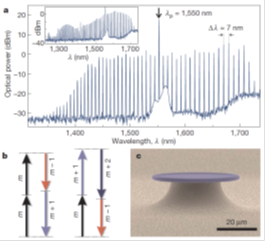
P. Del’Haye et al., Nature 450, 1214-1217 (2007)
The generation of optical frequency combs has become a powerful tool in optical physics within the past decade. The novel technique, awarded with the Nobel Prize for physics in 2005, has paved the way for ground breaking research in the fields of precision spectroscopy, gas sensing and astrophysical spectrometer calibration. While previously, frequency combs have been bulky and expensive devices, the development of on-chip comb generators in our research group has the potential for a variety of applications that require a compact frequency comb generator with low power consumption and a large comb mode separation. Particularly, these attributes make our monolithic comb generator an ideal tool for a range of applications like arbitrary optical waveforms, space borne frequency combs and precise calibration sources for spectrometers.
Frequency comb stabilization
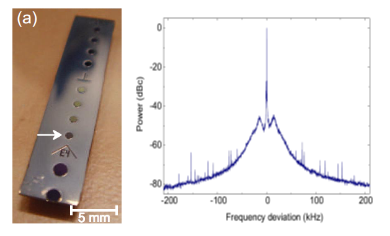
P. Del’Haye et al., Physical Review Letters 101, 053903 (2008)
An essential prerequisite for an optical frequency comb for all applications is the ability to stabilize it to an external reference signal, which in turn requires precise knowledge the two degrees of freedom defining an optical frequency comb (the spacing between the comb modes and the value of the carrier envelope offset frequency). The full stabilization of a microcavity-based frequency comb generator in conjunction with the generation of combs with mode spacings in the microwave regime has been demonstrated for the first time in our research group, which is a key pre-requisite for chip-based frequency comb generation.
Dispersion in optical microresonators
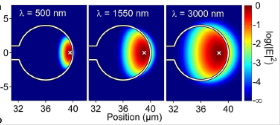
P. Del’Haye et al., Nature Photonics 3, 529-533 (2009)
The attainable bandwidth of optical frequency combs in microresonators is mainly limited by dispersion of the resonator (similar to mode locked lasers). Thus, a detailed understanding of the dispersive properties of microresonators is required in order to tailor dispersion for broadband frequency comb generation. We have developed a novel dispersion measurement scheme that utilizes an optical frequency to measure the exact frequency of microresonator modes, which in turn allows to determine the resonator’s dispersion. Additional finite element simulations indicate that the dispersion can be controlled and optimized by fine tuning the geometry of microresonator. This work enabled the generation of octave spanning frequency combs in microresonators for the first time.